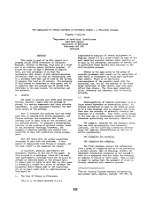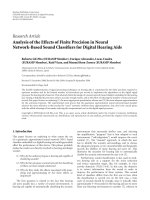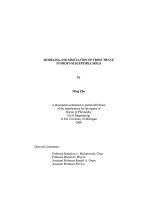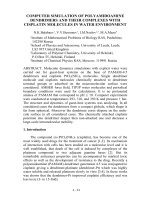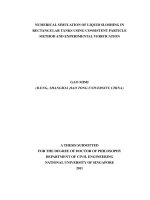Computer simulation of tracer diffusion in gel network
Bạn đang xem bản rút gọn của tài liệu. Xem và tải ngay bản đầy đủ của tài liệu tại đây (4.6 MB, 190 trang )
COMPUTER SIMULATION OF TRACER
DIFFUSION IN GEL NETWORK
ZHOU HUAI
A THESIS SUBMITED
FOR THE DEGREE OF DOCTOR OF PHILOSOPHY
DEPARTMENT OF CHEMICAL AND BIOMOLECULAR
ENGINEERING
NATIONAL UNIVERSITY OF SINGAPORE
2010
Computer simulation of tracer diffusion in gel network
i
ACKNOWLEDGEMENT
I would like to express my sincere appreciation to my supervisor, Prof. Chen
Shing Bor for his patient guidance, effective support and wise encouragement throughout
this research. His rigorous attitude towards research and serious working manner give me
a very deep impression and benefit me a lot for my future career.
Many thanks also go to all my labmates and friends: Mr. Kok Hong, Mr. Zhou
Tong, Mr. Zhao Guangqiang, Miss. Shen Yiran, Miss Chieng Yu Yuan, Miss. Moe Sande,
Mr. Zheng Zhangfeng, Miss Xue Changying, Mr. Li Jianguo, and Dr. Lim Wee Chuan, for
their support and assistant through the project. They made my stay in NUS much
enjoyable. My family members are also thanked for their support in my whole period of
study.
Finally, I wish to express my thanks to the National University of Singapore for
providing the financial support for this project and the research scholarship throughout my
whole period of candidature.
Computer simulation of tracer diffusion in gel network
ii
TABLE OF CONTENT
ACKNOWLEDGEMENT i
TABLE OF CONTENT ii
SUMMARY v
NOMENCLATURE
vii
LIST OF FIGURES xi
LIST OF TABLES
xviii
Chapter 1 Introduction 1
1.1 The need to understand the tracer diffusion in gel 1
1.2 Significance of computer simulations 4
1.3 Theoretical prediction of tracer diffusion in gel: computer simulation 5
1.4 Research objectives 8
1.5 Outline of the thesis 9
Chapter 2 Literature review 10
2.1 Theoretical background of computer simulation 11
2.1.1 Simulation methods 11
2.1.2 Interaction potentials 13
2.1.3 Coarse-graining and hybrid model 22
2.1.4 Periodic boundary condition (PBC) 26
2.2 Computer simulation of tracer diffusion in gel 27
2.2.1 Models of gel network 27
2.2.2 Diffusion behavior in polyelectrolyte gel 30
2.3 Physical models of diffusion in gel 35
2.4 Experimental study 37
Computer simulation of tracer diffusion in gel network
iii
Chapter 3 Brownian dynamics simulation of tracer diffusion in a cross-linked
network 39
3.1 Introduction 39
3.2 Description of the methods 43
3.3 Results and discussions 50
3.3.1 Uncharged network 52
3.3.2 Charged network 66
3.4 Conclusion 90
Chapter 4 Brownian dynamics simulation of chain diffusion in the polyelectrolyte gel
network 92
4.1 Introduction 92
4.2 Description of the methods 97
4.3 Results and discussions 102
4.3.1 Uncharged chain and gel 103
4.3.2 Charged chain and gel 114
4.4 Conclusion 126
Chapter 5 Dissipative particle dynamics simulation of tracer diffusion in gel network
127
5.1 Introduction 127
5.2 Description of the methods 133
5.3 Results and discussions 138
5.3.1 Solvent behavior 138
5.3.2 Diffusion behavior of network beads 141
5.3.3 Tracer diffusion in gel network 145
5.4 Conclusion 153
Computer simulation of tracer diffusion in gel network
iv
Chapter 6 Conclusion and recommendations 154
6.1 Concluding remarks 154
6.2 Recommendations 157
REFERENCES 158
Computer simulation of tracer diffusion in gel network
v
SUMMARY
Computer simulation is used to study tracer or chain diffusion in polyelectrolyte gels.
Owing to the limitation of present computer power, a mesoscopic approach is adopted to
handle long time dynamics in this thesis. Brownian Dynamics (BD) simulation is mainly
employed to study the self-diffusion of tracer particles and polymer chain in a cross-linked
gel network based on a coarse-grained bead-spring lattice model with a truncated
Lennard-Jones potential representing the excluded volume effect and a screened
electrostatic interaction accounting for charge effect. Several effects are investigated
including the network porosity, flexibility, degree of cross-linking (for tracer particle
diffusion only), and electrostatic interaction. In addition, Dissipative Particle Dynamics
(DPD) method is implemented to examine hydrodynamic interaction for tracer diffusion in
gel network that is ignored by BD simulation.
For tracer particle diffusion, the long-time diffusivity of tracer particle is studied in
both uncharged and charged system. It is interesting to find that for charged system the
diffusion is further hindered by the electrostatic interaction, regardless of whether the
tracer particle and the network are oppositely or similarly charged. However, there exists a
difference in the hindrance mechanism between the two cases. For the polymer chain
diffusion, the conformation and dynamic properties of polymer chains are examined. For
uncharged system, a decrease in diffusivity of chain is observed with the decrease of the
Computer simulation of tracer diffusion in gel network
vi
porosity of the network. The difference in diffusion behavior of an oppositely and
similarly charged chain in gel network is discussed for varied charge amount or Debye
length. The static properties of the chain are used to explain the difference between the
two cases, such as the average bond angle, the mean-square end-to-end distance, the
mean-square radius of gyration, and the three average eigenvalues of the moment of
inertia tensor. Finally, the applicability of the DPD method to study the hydrodynamic
interaction for the tracer diffusion in gel network is demonstrated, and the advantages or
disadvantages of the DPD and BD method are also addressed.
These computer simulation results based on the simplified coarse-grained model
shed light on the diffusion behaviour of a tracer particle or chain at mesoscopic level. The
unusual behaviour of tracer or chain caused by the attractive electrostatic force is
intriguing, which can be explained by electrostatic entrapment effect. This effect is
dependent on the charge, double layer thickness, and porosity.
Computer simulation of tracer diffusion in gel network
vii
NOMENCLATURE
Abbreviations Description
BD Brownian dynamics
COM center of mass
DNA deoxyribonucleic acid
DPD Dissipative particle dynamics
EVE Excluded volume effect
MC Monte Carlo
MD Molecular dynamics
MSD mean square displacement
RDF radial distribution function
SDE stochastic differential equation
VV velocity Verlet integrator
Symbols
a Radius of the particle
a
ij
The maximum repulsion force between particle i and j
D Long-time diffusivity of polyelectrolyte
D
0
Diffusivity of a particle at infinite dilute solution
e Unit vector
Computer simulation of tracer diffusion in gel network
viii
E
1
, E
2
, E
3
Eigenvalues of the moment of inertia tensor
E Moment of inertia tensor
F Force vector of all the particles
F
i
Force on particle i
F
C
i
Conservative force on particle i
F
D
i
Dissipative force on particle i
F
R
i
Random force on particle i
g(r) Radial distribution function
g
bb
(r) Radial distribution function for bead to bead
g
bc
(r) Radial distribution function for bead to COM
g
tb
(r) Radial distribution function for tracer to bead
H The minimum separation distance between the surfaces of particles
K Jump frequency, which depends on temperature and diffusant size
k Spring constant for network
k
B
Boltzmann constant
k
s
Spring constant for chain
l
0
Equilibrium bond length for network
l
0s
Equilibrium bond length for chain
l
B
Bjerrum length
L Length of simulation box
m Bead mass
Computer simulation of tracer diffusion in gel network
ix
M
The number of beads on one chain
MSD Mean square displacement
N Number of beads of network per dimension
Q Total effective charge on beads
r Distance between two particles
r
c
Cut-off length
r
cm
Center of mass of a chain
r
i
Position of bead i
R
g
Radius of gyration of a chain
R
n
end-to-end distance of a chain
R
n
end-to-end vector
R random force
t Time
T Temperature
U
ij
Total interaction energy
U
el
Electrostatic interaction energy
U
ex
Lennard-Jones potential
U
sp
Elastic bond energy
v
Exponent of scaling laws
v
velocity
Computer simulation of tracer diffusion in gel network
x
w Energy depth of Lennard-Jones potential
Z
Bead charge
Greek Letters
α
Correction factor
κ Screening parameter
Β Porosity
∆t Integral time step
∆W Random number vector of Wiener process
ε
Permittivity of the solvent
φ
Volume fraction of beads
λ Debye screening length
µ
Solvent viscosity
θ Bond angle between two connectors of a chain
θ
ij
Random number
σ Distance parameter of Lennard-Jones potential
ζ
Friction coefficient
ξ Correlation length or network mesh size
Ψ
i
Surface electrical potential of particle i
Computer simulation of tracer diffusion in gel network
xi
LIST OF FIGURES
Figure Title Page
Figure 2.1 Flowchart for a typical BD algorithm. 14
Figure 2.2 Coarse Grained Bead – Spring Model of a polymer network with
periodical boundary condition.
24
Figure 2.3 Schematic representation of a 2D periodical system 26
Figure 3.1 Schematic of a bead-spring cross-linked network. Each stick
connector represents a spring.
44
Figure 3.2 The time step in predictor/corrector method
47
Figure 3.3
Normalized long-time tracer diffusivity for uncharged systems
52
Figure 3.4.
The long- time diffusivity of tracer particle in neutral gel
network vs. the different spring constant between network beads;
the dot line is the linear fit of points
53
Figure 3.5
Mean square displacement of the tracer in a 100% cross-linking
uncharged network
54
Figure 3.6
Normalized tracer diffusivity versus time for a 100%
cross-linking uncharged network with varying spring constant at
β
= 0.818 (a) and 0.728 (b).
56
Computer simulation of tracer diffusion in gel network
xii
Figure 3.7
Radial distribution function for uncharged network with different
spring constant: (a) bead – bead; (b) bead – COM.
57
Figure 3.8
Normalized long-time tracer diffusivity versus degree of
cross-linking for an uncharged network with k=80 and varying
porosity.
60
Figure 3.9 The comparison of RDF of tracer-bead with different porosities
and different cross-linking degrees (spring constant k=80) (a)
β
=0.966 (b)
β
=0.886 (c)
β
=0.818
63
Figure 3.10
Pair radial distribution function for uncharged network with
k=80, β=0.818 varying degree of cross-linking: (a) tracer-bead,
(b) bead-bead. (c) bead-COM
64
Figure 3.11
Normalized long-time tracer diffusivity versus spring constant
for an uncharged network with β=0.818 and varying degree of
cross-linking.
65
Figure 3.12
Normalized tracer diffusivity versus time for a 100%
cross-linking charged network with k=80, λ=0.5, |Q|=12 and
varying porosity: (a) similarly charged (b) oppositely charged.
67
Figure 3.13
Normalized tracer diffusivity versus time for a 100%
cross-linking charged network with k=80, λ=0.5, |Q|=18 and
varying porosity: (a) similarly charged (b) oppositely charged
68
Figure 3.14
Parameter for double layer overlapping as a function of network
porosity.
70
Computer simulation of tracer diffusion in gel network
xiii
Figure 3.15
D/D
0
vs. time: the oppositly charged tracer in 100%
cross-linked network Q=12, λ=0.5
72
Figure 3.16 The radial distribution function of tracer-bead in charged
network with varied charge on each beads (β= 0.9995 and λ=
0.5): (a) similarly charged; (b) oppositely charged.
75
Figure 3.17
The radial distribution function of tracer-bead in similarly
charged network with β=0.9995 and Q=12: (a) similarly charged,
(b) oppositely charged.
77
Figure 3.18
Normalized long-time tracer diffusivity versus degree of
cross-linking for a charged network (hollow symbols) with
|Q|=12, λ=0.5 and k=80: (a) similarly charged, (b) oppositely
charged. The results for the corresponding uncharged
counterparts are also shown (filled symbols) for comparison.
78
Figure 3.19
The comparison of radial distribution function of tracer for the
similarly charged cross-linked network with different porosities
(beads sizes) and different cross-linked degrees (spring constant
k=80) (a) β=0.996 (b) β=0.966 (c) β=0.886
81
Figure 3.20
The comparison of radial distribution function of tracer for the
oppositely charged cross-linked network with different porosities
(beads sizes) and different cross-linked degrees (spring constant
k=80) (a) β=0.996 (b) β=0.966 (c) β=0.886
82
Computer simulation of tracer diffusion in gel network
xiv
Figure3.21
Radial distribution function of bead-tracer pairs for a charged
network with k=80, |Q|=12, λ=0.5 and β=0.966: (a) similarly
charged (b) oppositely charged.
84
Figure 3.22 Pair radial distribution function for a network with with k=80,
|Q|=0 or 12, λ=0.5,β=0.966: (a) tracer-bead [100% cross-linking]
(b) bead-bead [100% cross-linking] (c) tracer-bead [50%
cross-linking] (d) bead-bead [50% cross-linking].
85
86
Figure 3.23
Normalized long-time tracer diffusivity versus dimensionless
double layer thickness for a charged network with k=80, |Q|=12
and β=0.9995: (a) similarly charged, (b) oppositely charged.
88
Figure 4.1
Schematic of a bond angle between two connectors of a chain.
100
Figure 4.2.
Various properties of the diffusing chain versus the chain spring
constant in a rigid network with β=0.934: (a) chain diffusivity,
(b)
θ
cos , (c) mean-square end- end distance, and (d)
mean-square radius of gyration.
103
Figure 4.3.
Average eigenvalues for the moment of inertia tensor of a
diffusing chain in a rigid network with β=0.934.
106
Figure 4.4
Variation of chain diffusivity with the spring constant of the
network for β= 0.934 and k
s
=10
107
Figure 4.5. Diffusivity of the chain with k
s
=10 versus the network porosity
for a rigid network or a flexible network (k=80).
108
Computer simulation of tracer diffusion in gel network
xv
Figure 4.6. Conformation behavior of the chain with k
s
=10 versus the
network porosity for a rigid network: (a) mean-square end-end
distance, (b) mean-square radius of gyration, and (c)
><
θ
cos
109
Figure 4.7.
Distribution functions of the static properties of the chain (M=3)
in the presence or absence of a rigid network: (a) square of
end-to-end distance, (b) bond angle θ, (c)
θ
cos , and (d) bond
lengths.
113
Figure 4.8.
Conformation of a charged chain (k
s
=10) versus the double layer
thickness in the absence of a network: (a) mean-square gyration
radius normalized by the uncharged counterpart, and (b)
>
<
θ
cos
.
115
Figure 4.9. Normalized chain diffusivity versus double layer thickness for
k
s
=10, k=80, and β=0.996: ++ (|Q|=6 (a), |Q|=9 (b), |Q|=12 (c))
and +- (|Q|=6 (d), |Q|=9 (e), |Q|=12 (f)) denote the similarly and
oppositely charged cases, respectively
116
117
Figure 4.10
Variations of <R
g
2
> (a) and >
<
θ
cos (b) of the diffusing chain
with λ for k
s
=10, k=80, |Q|=9, and β=0.996: +- and ++ denote the
oppositely and similarly charged case, respectively
120
Figure 4.11.
Distribution of
>
<
θ
cos
of a diffusing chain with k
s
=10 and
122
Computer simulation of tracer diffusion in gel network
xvi
M=3 in a charged network with k=80, β = 0.996, and λ=0.5: ++
and +- denote similarly and oppositely charged cases,
respectively.
Figure 4.12.
Normalized chain diffusivity versus porosity for |Q|=9, k
s
=10,
k=80, and λ=1.0: ++ and +- denote similarly and oppositely
charged cases, respectively.
123
Figure 4.13.
Mean-square gyration radius of the diffusing chain normalized
by the value in the absence of the network as a function of
porosity for |Q|=9, k
s
=10, k=80, and λ=1.0: ++ and +- denote
similarly and oppositely charged cases, respectively.
125
Figure 5.1 The accuracy of different time step in two different porous
networks.
136
Figure 5.2
Radial distribution functions g(r) for model B; a
ij
is 0, 10, 25, 45
or 65.
139
Figure 5.3
MSD of network beads for different porosities of the network
(k=80). The inset is the tracer MSD for comparison.
141
Figure 5.4 Deviation of the diffusivity of the network beads from the
free-draining case as a function of the bead volume fraction
(1-
β
).
144
Figure 5.5. The normalized diffusivity of tracer in gel network with various 145
Computer simulation of tracer diffusion in gel network
xvii
porosities
Figure 5.6
the normalized diffusivity of tracer in gel network with various
flexibilities, porosity of network is 0.886; (a) by DPD method
(b) comparison between DPD and BD
147
Figure 5.7
Comparison of tracer diffusivity in uncharged gel network with
various porosities by DPD and BD.
149
Figure 5.8
Comparison of tracer diffusivity in charged gel network with
various porosities by DPD and BD; k =80, Q=12, λ=0.5. ++
repulsively charged, +- oppositely charged.
151
Computer simulation of tracer diffusion in gel network
xviii
LIST OF TABLES
Table Title Page
Table 2.1 Summary of the physical models of diffusion in polymer
solution and gel
36
Table 3.1 Relation between l
0
/σ and β.
45
Table 3.2 The influence of excluded volume effect (EVE) in 100%
cross-linked degree network
50
Table 3.3
The system sizes in simulation
51
Table 3.4 Normalized long-time tracer diffusivity for uncharged systems
with 100% cross-linking.
59
Table 3.5 Normalized long-time tracer diffusivity for similarly-charged
systems with λ=0.5 and 100% cross-linking.
66
Table 3.6
Normalized long-time tracer diffusivity for oppositely-charged
systems with λ=0.5 and 100% cross-linking.
73
Table 3.7
Normalized long-time tracer diffusivity for charged systems with
β=0.9995 and 100% cross-linking: ++ is similarly charged; +- is
oppositely charged.
76
Computer simulation of tracer diffusion in gel network
xix
Table 4.1.
Test for the system size of an uncharged network with k=80 and
k
s
=10.
102
Table 5.1
Integration scheme of DPD-VV
137
Table 5.2.
Diffusivity comparison between the tracer and the network
beads. Note that the simulation box contains N×N×N network
beads.
143
Table 5.3
Comparison between BD and DPD for the long-time diffusivity
of tracer in gel network with various flexibility of network
145
Chapter 1
1
Chapter 1
Introduction
In recent years, the study concerning diffusive process of tracers in polymer gel
system has received considerable attentions. As a tracer, the particle or single chain
diffusion is strongly affected by its interaction with the constituents and the microstructure
of the matter. Therefore, understanding particle or single chain diffusion in a network is
essential for a variety of practical applications. For the past decades, computer simulation
has been proven adequate to study the microstructure and dynamics of polyelectrolyte gels.
In this thesis, Brownian dynamics and Dissipative Particle Dynamics simulation methods
are implemented to study the self-diffusion of tracer or polymer chain in polyelectrolyte
gel system. Despite a comparatively simple bead-spring model of polyelectrolyte gel
applied in this work, the dynamic properties of particle or single polymer chain still show
a strong dependence on the structural or chemical properties of the polymer gel system.
1.1 The need to understand the tracer diffusion in gel
network
A polymer gel is an elastic cross-linked polymer network with a fluid filling the
interstitial space of the network. Polymer gels are wet and soft and look like a solid
material, but are capable of undergoing large deformations. Living organisms are largely
made of gels. Except for bones, teeth, nails, and the outer layers of skin, mammalian
tissues are highly aqueous gel materials that are largely composed of protein and
polysaccharide networks in which the water contents are up to 90% (blood plasma). This
Chapter 1
2
makes it easier for the organism to effectively transport ions and molecules while keeping
its solidity. As one of the most important polymer gels, a polyelectrolyte gel is a network
of charged polymers. The dynamic properties of polyelectrolyte gels can vary in response
to the changes in the properties of the surrounding medium (i.e. pH, presence of ions, etc.)
or external inputs. For instances, ployacrylamide-co-sodium is a typical polyelectrolyte
gel and can be used as a model material. The charge effect plays an important role in the
behavior of this gel. It can affect phase behavior of polyelectrolyte gel as well as the
corresponding transition process significantly. Another interesting polyelectrolyte gel is
polyampholyte, which contains both cationic and anionic groups in its structure. Therefore
polyampholyte molecules can be either positively or negatively charged, with more
complicated behavior of repulsion and attraction.
According to the above properties, polymer gels have become increasingly
important in human’s life, such as personal care products (e.g., diapers, feminine care
products, and incontinence products); industrial separations (e.g., waste water treatment,
membrane processes, and protein and biological purification process); and
pharmaceuticals (e.g., controlled-release technology, bioadhesives, and enteric dosage
forms). To develop practical applications of polymer gel, a fundamental understanding of
the small molecule (tracer) diffusion in gel is required.
Although polymer gels are important, understanding their mechanisms is extremely
difficult due to the many complicated factors involved. First, unlike the diffusion process
in dilute polymer solution, the gel system is highly concentrated with complicated internal
Chapter 1
3
structure. The network of a gel is dynamic and could be unstable. For instances, the
cross-links in a polymer gel (physical gel) are dynamic, and can break up or construct
according to the change of surrounding conditions. It also can swing due to conflictions by
the surrounding molecules (e.g., solvent or the polymer molecules). Consequently, the
continual changes of a gel network affect the tracer diffusion in the gel network. Second,
the diffusion of a tracer in gel network is sensitive to the tracer-gel interaction potential
which depends on various surrounding conditions, such as concentration of gel,
temperature, pH, ionic strength, electric field and solvent system. A small variation in
these variables may influence the tracer diffusion significantly. Finally, most experiments
on the tracer diffusion in gel network are always constrained by the limitations of
experimental methods. For examples, the light scattering method is a popular method to
measure the dynamic profile of tracer diffusivity, but this experiment needs highly
transparent solution to ensure single scattering. Also, the size of dye in fluorescence
correlation spectroscopy also brings error in measurement, and the small value of tracer
diffusivity can influence the accuracy of electron spin resonance image (ESRI) and
nuclear magnetic resonance (NMR) methods. Unfortunately, so far we can not find an
experimental method for tracer diffusion in gel network without any limitations, and most
experimental conditions are obtained by trial and error. It remains a challenge to find
efficient experimental methods for tracer diffusivity in many polymer gel systems.
Therefore, to find a useful alternative method to study the diffusion in gel becomes one of
the objectives in this study.
Chapter 1
4
1.2 Significance of computer simulations
To widen and improve the use of polymer gels, computer simulation is an
alternative approach by which various aspects of gel behavior can be investigated.
Computer simulations play an important role to predict the results for problems in
statistical mechanics which might be quite intractable by approximated method. It is also a
useful tool to complement experimental studies, in which one may encounter difficulties
in controlling parameters, and measuring certain physical properties. To some extent,
computer simulation can be viewed as a testing tool of theories by idealized ‘experiments’.
Also, the results of computer simulations may be compared with those of real experiments
and provide insight into the underlying physics of experimentally observed behavior. This
dual role of simulation, as a bridge between models and theoretical predictions on the one
hand, and between models and experimental results on the other, is illustrated by Allen
and Tildesley (1987).
Since macroscopic properties of experiment (the equation of state, transport
coefficients, structural information and so on) can be correlated to the microscopic details
of a system (the masses of the atoms, the interactions between them, molecular geometries
etc.), computer simulation could be used to study a lot of physical phenomena at
molecular scale, for example crystallization, tracer’s diffusion, phase transition, and so on
(Hockney and Eastwood, 1981).
Chapter 1
5
1.3 Theoretical prediction of tracer diffusion in gel
network: computer simulation
Some scientists have successfully obtained the tracer diffusivity in gel network
using computer simulation. However, computer simulation of a gel system is
time-consuming in contrast to the computation for the dilute polymer solution. This is
because if an atomistic level model is applied to each molecule, there will be millions of
atoms and the amount of calculation is beyond the capacity of current computers.
Therefore, for an efficient and larger-scale computer simulation, a coarse-grained model
of polymer gel would be used preferably.
Several simulation methods have been used to study polymer gels, such as
Molecular Dynamics (MD), Brownian Dynamics (BD), Monte Carlo (MC) and
Dissipative Particle Dynamics (DPD) simulation methods. MD, DPD and BD are usually
used in dynamics problems; while MC simulation is mainly applied to equilibrium
properties. There are two kinds of MD method. The typical one uses a particle to represent
each atom or molecule including solvent molecules, while the other one is coarse-grained
by treating the solvent as a continuum. Compared with BD, the latter MD method retains
the particle inertial effect in the equation of motion, and therefore it can examine
dynamics properties at smaller time scale. DPD is similar to the first kind of MD method,
but it always employs a ‘soft’ repulsive interaction instead of ‘real’ atom interaction used
in MD method. The short-time detailed behavior may not be reflected sufficiently in DPD
simulation that advantageously uses a time step. Nevertheless, MD method is a very time
consuming method as the model of this simulation method and its time step are all
